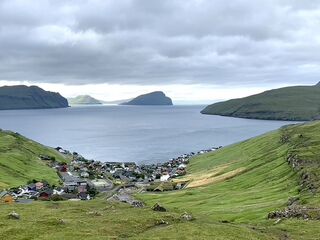Health
Adventuresome Travel at Any Age
A Personal Perspective: Age is not a relevant obstacle in the Faroe Islands.
Posted October 30, 2022 Reviewed by Jessica Schrader
Key points
- It seems to be a myth that people become less adventuresome in general, and with regard to travel, as they age.
- Unlike earlier generations, many of today's seniors want to explore their world more fully.
- Surprisingly, the far-flung Faroe Islands provide a perfect venue for older adults to navigate. Age is not a relevant obstacle there.

There was a time when retirement meant taking a seat on the porch rocking chair and watching the world go by. That was when the average mortality age was about 60. But now many seniors, who have the means and a modicum of health and ambulation, want to explore their world more fully.
There is an old myth that suggests that people become less adventuresome, in general, and also as it pertains to travel, as they age. I haven’t seen that idea substantiated by any facts. As someone who is now considered by others as old, I can’t see why that would be true, assuming that significant health or cognitive problems don’t interfere. The myth suggests that one’s world and interests shrink, perhaps in proportion to one’s height? Of course not. I jest.
The travel industry once targeted the 65- to 75-year-old cohort as perfect for cruise traveling. This is the population known as young-old. An AARP survey of adults between the ages of 54 and 72 found that virtually all of them planned to take at least one domestic trip in 2019. But little attention gets paid to the 75-plus age group, a very fast-growing segment of society in most developed countries.
A recent study, “Understanding the Value of Tourism to Seniors’ Health and Positive Aging,” looked at several variables including mental and physical health benefits of travel in an older population. In addition to the anticipated outcomes that suggested mental and physical health benefits, “this study unexpectedly found that respondents who participate in frequent travel experience have become more optimistic in outlook, and are able to actively and positively think outside their original closed environment when facing setbacks and difficulties.”
While this study was very comprehensive, it did not include in its sample adults over the age of 75, a population referred to as old-old, which I find to be a disrespectful categorization. Yet there is no reason why older adults, and here I mean the old-old or those of any age, can’t travel far and wide. And a recent trip reminded me of that.
I'd never heard of the Faroe Islands before traveling from Western Norway to Iceland. As we approached, the looming, rugged, towering peaks of Torshavn didn't seem a hospitable place and as I looked around at the mostly older adults disembarking the cruise ship, I wondered how we'd manage to get around once on land.
The cruise ship travelers who disembarked appeared to be divided between the young-old, generally ages 60-75, and the old-old, ages 75-85, with a few ancient ones, probably above age 85. As it happens, these islands provide a perfect venue for older adults to navigate. Surprisingly, the streets of the capital were mostly flat or gently sloping and meander past turf-topped houses, built as the Vikings did when they invaded and settled around 800 AD.
Halfway between Iceland and Norway in the North Atlantic sea sits the Faroe Islands, inhabited since at least the 6th century when monks sailing north from Ireland first discovered the place and settled there. From a distance, the destination looked like a clump of uninhabited and unfriendly volcanic peaks and outcroppings in dreary charcoal gray rising from the sea and nothing more. This craggy, wind-swept land where my ship docked seemed like an unlikely place to spend the day but I'm so glad that I did.
In Many Ways, a Modern City
From the dock to the center of Torshavn, a short comfortable walk, visitors can immediately spot the parliament building currently in use, but many centuries old, built on the site of the Vikings' original settlement in the 9th century. Called Tinganes, which means "parliament point" in Faroese, this parliamentary meeting place is one of the oldest in the world dating back to the Viking period.
Peeking through the windows of the squat red brick buildings with grass roofs, it seemed incongruous to see computers and other modern technologies sitting on desks inside. But in many ways this is a modern city, with good cellphone reception.
Though there are 22 islands comprising the Faroe Islands, only three have much population. While the total population holds steady at around 30,000, currently 13,000 reside in the capital city of Torshavn, which I found charming to walk by foot.
A Pleasing and Peaceful Place
Although off the beaten path, and maybe because of it, this is a pleasing, peaceful, and physically breathtaking place to spend time. Here you are, away from the hustle and bustle of tourist spots with all-alike shopping malls and frenzied travelers.
And in the middle of the North Atlantic Ocean, this place gives you a respite from the geo-political aggravations that persist almost everywhere these days. Escape for a short while from the troubles in America, Europe, and the Middle East.
In the ocean midway between Norway and Iceland and due north of the tip of Ireland and Scotland, this far-flung archipelago is a Danish protectorate and a place where the old Norse language is still spoken. Also, thanks to Denmark, there are a series of bridges and tunnels that can take you, in your rented car, to other islands. Perfect for those who wish to explore the Viking history and natural beauty. Whether you are a seasoned mountain climber or a more sedentary person who prefers to view the scenery from a car, this place is for you.
Something for Everyone
There is much to see beyond the capital city. If you are a nature lover, you are in for a treat as the mountain roads look down at incredibly dramatic views of fjords. You can take the 3-mile underwater tunnel to Vágar, where the charming village of Sandavagur was first settled by the Vikings. Wherever you drive, across many bridges or through the numerous tunnels, you arrive at scenery that is magnificent, from the coastal vistas to the soaring peaks.
From the look of the islands, the gray foreboding sky, and the appearance of the Northern Lights at certain times of the year, you'd think that the weather so close to the arctic circle would be terribly cold all of the time. In fact, the temperature seldom goes below freezing, with less than an inch of snow, and cool summers with highs in the mid-50 degrees—in many ways, a temperate climate.
Getting there is surprisingly easy by ship travel between Norway and Iceland, a plus for retirees who make up the majority of cruise ship passengers. There are also ferries between Iceland and Faroe Islands that carry cars so that you can explore the islands easily—a benefit to older, less ambulatory adults. There are also daily flights to Torshavn from several major cities including Copenhagen, Denmark; Oslo, Norway; Reykjavik, Iceland; and even Paris, France.
Modern, medieval, and early Christian periods complement each other in this unusual venue. Here there is something for everyone: lovers of history, birders, explorers, and hikers on foot will all find their time in this place special and unique. Your age is not a relevant obstacle here.




